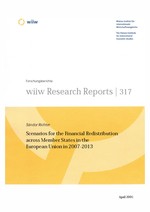Scenarios for the Financial Redistribution across Member States in the European Union in 2007-2013
wiiw Research Report No. 317, April 2005
131 pages including 34 Tables and 4 Figures
The order and modalities of cross-member state redistribution as well as the net financial position of the member states are one of the most widely discussed aspects of European integration. The paper addresses selected issues in the current debate on the EU budget for the period 2007 to 2013 and introduces five scenarios. The first is identical to the European Commission's proposal; the second is based on reducing the budget to 1% of the EU's GNI as proposed by the six major net-payer countries while maintaining the expenditure structure of the Commission's proposal; the third is 'halfway' between the first and the second scenarios. The next two scenarios represent radical reforms: the fourth scenario also features a '1% EU GNI'; however, the expenditures for providing 'EU-wide value added' are left unchanged and it is envisaged that the requisite cuts will be made in the expenditures earmarked for cohesion. The fifth scenario is different from the fourth in that the cohesion-related expenditures are left unchanged and the expenditures for providing 'EU-wide value-added' are reduced. After the comparison of the five scenarios, we analyse the allocation of transfers to the new member states in terms of the conditions prevailing in the different scenarios. The impact on demand and on external and fiscal balances are discussed. Next, characteristic features of the position of Austria, Germany, Hungary, Poland and Slovenia vis-à-vis the European Commission's proposal for the 2007-2013 financial perspectives are addressed. Then the new member states' first experiences with the absorption of EU transfers are reviewed. Finally, the global impact of a success or failure of redistribution across member states in the European Union is analysed.
Keywords: European integration, EU, redistribution across member states, scenarios, cohesion, competitiveness, budgetary reforms, EU financial perspective, EU budget, own resources and expenditures, net financial position
JEL classification: F15, F36, F47, H29, H49, H77, H87, R11
Countries covered: Austria, European Union, Germany, Hungary, New EU Member States, Poland, Visegrad countries
Research Areas: Macroeconomic Analysis and Policy, International Trade, Competitiveness and FDI
